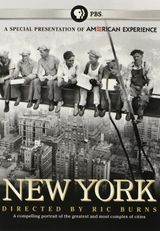
New York: A Documentary Film 1
1999-11-14 | Documentary | 8 episodes1 Season
Episode
The Country and the City (1609–1825) (1999)
The series begins by identifying the key themes that shaped New York's history: commerce and capitalism, diversity and democracy, transformation and creativity. The episode charts the development of the city founded by the Dutch as a purely commercial enterprise, first as New Amsterdam, a freewheeling enclave of trade and opportunity; then as the British New York, a colony fueled by slavery which was bestowed as a birthday gift upon the Duke of York by his brother, King Charles; soon after as a strategically pivotal locale in the American Revolution; and ultimately as the city of New York: the nation's first capital and the place destined to define urban life in America -- and American ideals.

Order and Disorder (1825–1865) (1999)
Already established as America's premier port, New York City swelled into the nation's greatest industrial metropolis as a massive wave of German and Irish immigration turned the city into one of the world's most complex urban environments, bringing with it a host of new social problems. Episode Two reveals how the city's artists, innovators and leaders, from poet Walt Whitman to Frederick Law Olmsted and Calvert Vaux (the designers of Central Park) grappled with the city's growing conflicts -- which culminated in the catastrophic Civil War Draft Riots of 1863.

Sunshine and Shadow (1865–1898) (1999)
Now the spotlight shines on the growth, glamour and grief of New York during America's giddy postwar "Gilded Age." Exploring the incomparable wealth of the robber barons and the unabashed corruption of political leaders, such as Tammany Hall boss William M. Tweed, the episode examines the era when the expansion of wealth and poverty -- and the schism between them -- built to a crescendo. The program ends as the city itself dramatically expands its boundaries, annexing Brooklyn, Queens, the Bronx and Staten Island into a single massive metropolis -- Greater New York.

The Power and the People (1898–1918) (1999)
As New York spilled into the new century, the extraordinary interplay of capitalism, democracy and transformation surged to a climax. During a single generation, over 10 million immigrants arrived in New York. The city itself became an even more dramatic lure with the construction of the first subways and skyscrapers. And arising from the plight of New York's most exploited citizens came landmark legislation that would eventually transform the lives of all Americans.

Cosmopolis (1919–1931) (1999)
In this short but dazzling period, New York became the focal point of an extraordinary array of human and cultural energies, reaching its highest levels of urban excitement and glamour. In just over a decade, New York gave birth to its signature skyscrapers, the Chrysler and Empire State Buildings, and to artistic creations like F. Scott Fitzgerald's THE GREAT GATSBY, George Gershwin's "Rhapsody in Blue," and to the jazz compositions of Duke Ellington and Louis Armstrong. Along the way, Harlem emerged as the undisputed capital of the African- American experience and the new media industries of advertising, radio networks, public relations, and magazines found their homes in midtown Manhattan.

Cast
View Live Cast Profile
Photo




